Inset stainless steel kitchen sinks: features and choices
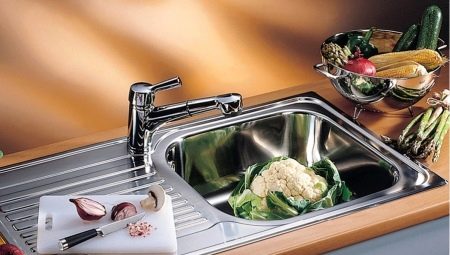
The kitchen sink is in the category of the primary components of the interior: the level of convenience in the process of preparing food and washing kitchen utensils may depend on the competent choice of the product. Today, there is a huge selection of such products on the market, as a result of which it will not be easy to choose the perfect sink for the kitchen without some knowledge in this area. Overhead and mortise products are in particular demand. It's actually about inset sinks and, in parallel, about the key aspects of their choice and purchase, we will talk in this publication.
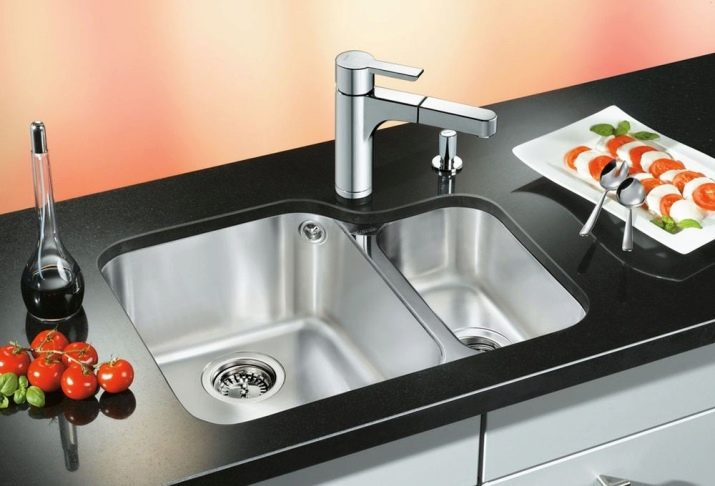
Description
In difficult conditions of using the kitchen area, inset sinks made of non-corrosive steel are simply irreplaceable products. Let's consider in all details the pros and cons of cut-in products for the kitchen: their varieties, sizes and shapes, how they are made and who does it best. This will make it possible to choose the ideal option.
Stainless steel mortise sinks have many positive qualities.
- Non-corrosive steel products are distinguished by excellent properties, among which reliability, durability and long service life are key. In addition, the sink is very easy to install, maintain and comfortable to use. All these parameters make plumbing made of non-corrosive steel quite popular and hot commodity.
- When working with a liquid medium, stainless steel sinks are simply irreplaceable. The name of the material alone declares that the occurrence of corrosion is not afraid of it. And this is true - the sink is not afraid of regular contact with liquid, the effects of high temperatures and strong humidity in the room.Will not damage the material and the influence of household chemicals for various purposes.
- Despite the fact that small thickness steel is used for the manufacture, the shell comes out quite durable... It is, in fact, impossible to change its configuration or pierce it through with simple use in the kitchen. If the shell is not subjected to a crash test for strength with heavy objects, then it will serve for more than a dozen years without problems, at the same time its external data will not change.
- The non-corrosive steel sinks are also quite comfortable to use. They are simple and easy to wash, for this you do not need to purchase specialized detergents and cleaners, a simple powder and gel for sanitary ware is enough. Stainless steel provides a high level of home hygiene, which is why these sinks are practiced in restaurants and cafes.
- The cut-in version of the design is universal. In comparison with overhead sinks, it does not require deliberately looking for kitchen furniture in size. Mortise products can be mounted in a work surface made of any material. The main thing is that the width of the furniture fits the width of the sink. In addition, it should be noted the stylish appearance of the cut-in sinks, they will perfectly harmonize with any interior design. In outlets there are both matte and glossy samples, therefore, there is plenty to choose from.
Important! It is really possible to cope with the installation of a mortise sink on your own.

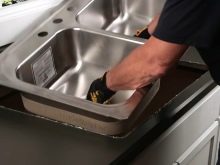
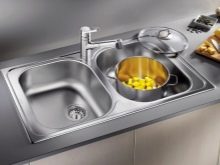
Non-corrosive steel, as a material used for sinks, has its drawbacks, only they are easy to eliminate.
- Reduced noise absorption coefficient. In such a sink, you can actually hear the sound of water flows and the impact of dishes. If this really causes problems, then it is preferable to take products made of thick steel or with a sound absorber made of soft materials under the bowl. There will be no loud sounds in these sinks.
- During use, the surface quickly becomes covered with limescale and grease stains. Only this blemish is trifling, since it is extremely easy to wash non-corrosive steel.
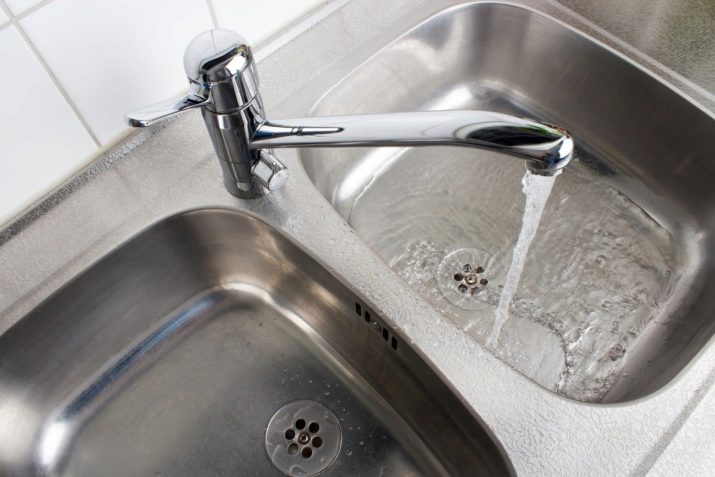
Varieties
All non-corrosive steel sinks can be divided into two groups.
Stamped products
The advantage of this type is the absolute absence of seams, since the sinks are made from solid steel sheets. This ingenuous production technology also seriously affects the price of sanitary products. Of course, there are also disadvantages, the depth of the bowl of such a sink will be no more than 15 centimeters. For a family of four or more, this is inconvenient, since many kitchen items will need to be washed, and this will be uncomfortable. In addition to the small depth, stamped products have one more drawback - non-uniform wall thickness.
This happens when the manufacturer uses insufficient quality steel in order to save money.
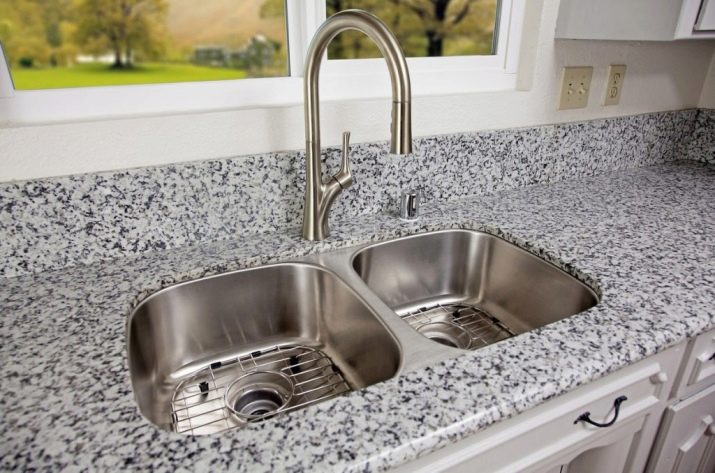
Welded sinks
In comparison with stamped shells, welded products are the most comfortable and high quality. But you will also need to pay more for such a sample. This sink is assembled from two elements: a bowl and a bottom, so you can choose both a deep sink and not so much. Elements in between are combined by welding. Particular attention should be paid to quality here, as the connection areas can become a "pig in a poke" and cause leaks. That's why experts advise taking products from well-established companies.
If we talk not about the manufacturing method, but about the configuration, then rectangular, round and corner sinks with single, two or three bowls are especially popular. In addition to such plumbing equipment, there is often a "wing" that acts as a dryer. Such sinks will be much more functional than an ordinary bowl, since they make it possible to easily drain water from the dishes back into the sink, and not into the bedside tables or onto the work surface.
If the sink is completed with two bowls, then this is quite practical, one of them can be used for laying unwashed dishes, defrosting food and other purposes.
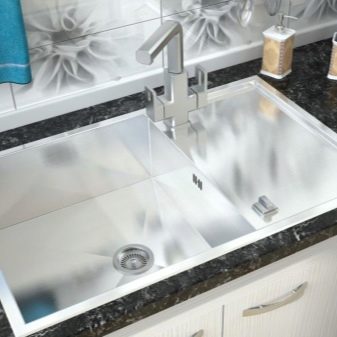
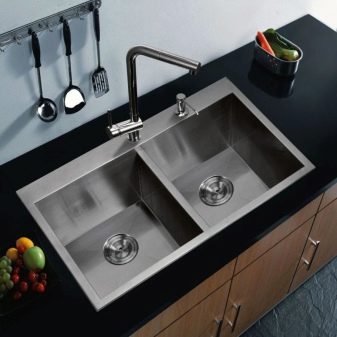
The shape and dimensions of the sinks
Manufacturers today offer sinks in a variety of configurations and sizes.
- Square. It is characterized by its ease of use and capacity. Among the dimensions of square shells, the most popular are 50x50 or 60x60 centimeters.
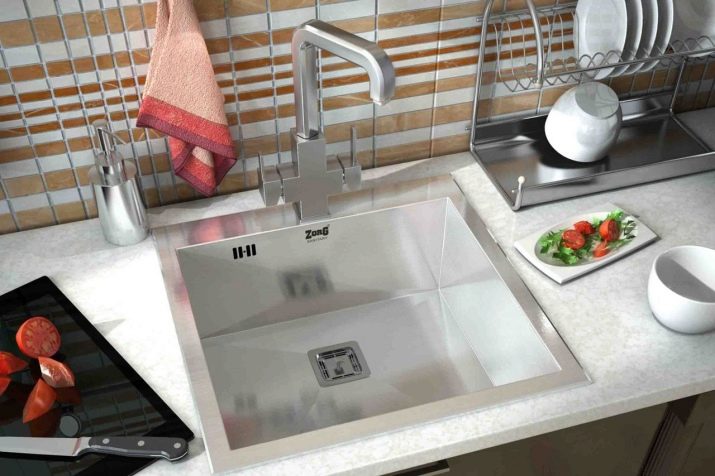
- Rectangular. It is used in kitchens where there is a narrow bedside table or tabletop. But you need to understand that a narrow rectangular sink is not very comfortable, since the number of sprays when used directly depends on the width. Such shells are 50–55 centimeters wide, and vary in length, from 50 to 125 centimeters.

- Round. A bowl with this configuration is easy to clean and has a capacity much larger than a rectangular sink. The dimensions of round sinks are measured in diameters, mostly 45-51 centimeters.
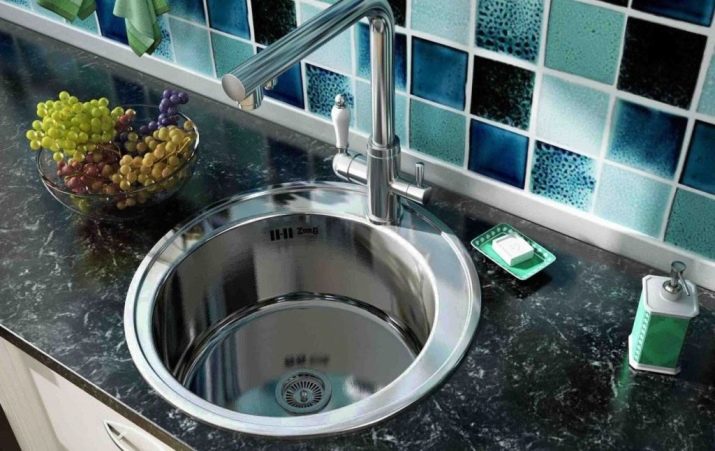
- Trapezoidal with 5-6 angles. This model is practiced in corner or spacious kitchens.
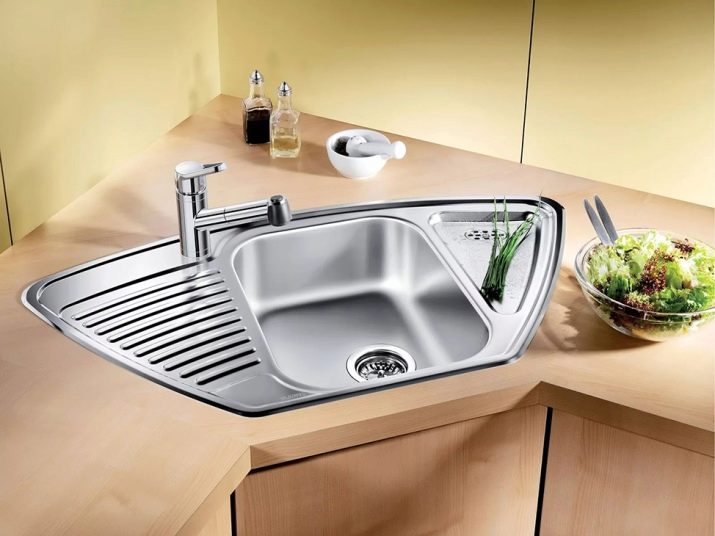
- Non-standard. For fans of a special style, there are sinks in the shape of a triangle or oval. Some companies even sell heart-shaped sinks.
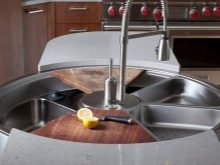
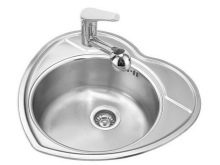
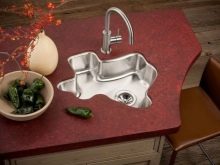
Popular manufacturers
It is worth considering the rating of the most popular manufacturers.
- Omoikiri. It is a Japanese manufacturer of sanitary products. Previously, the company specialized exclusively in granite products. Steel sinks have now been added to the list.
The production procedure assumes control at several levels, which guarantees that the finished products comply with all standards.
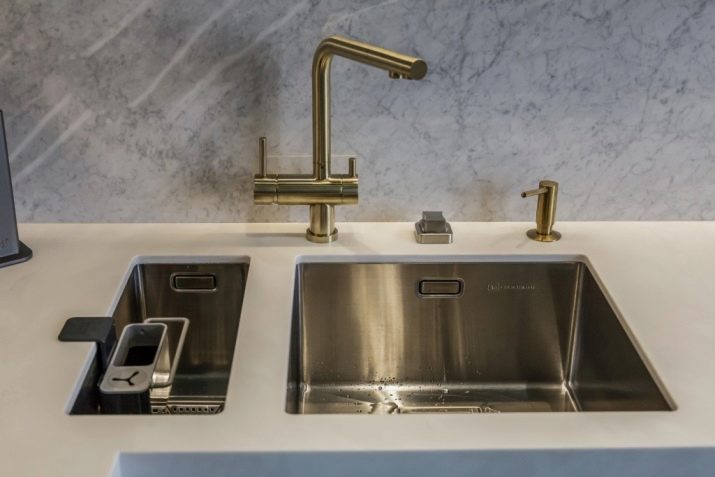
- Alvenus. This company from Slovenia is also known for its sanitary ware, pleases consumers with prices. Like other reputable kitchen sink companies, Alvenus offers an extensive range of non-corrosive steel products. A good plus for the consumer can be an impressive set of additional equipment, which is included in the kit or purchased separately.

- Reginox. This manufacturer from Holland is engaged in the production of various sanitary ware. The main focus is stainless steel kitchen sinks. 70% of products are made from used metal, which determines the care for the environment. Great attention is paid to design.
The choice is rich both in terms of types and cost, so it will be easy for every consumer to find an acceptable option.
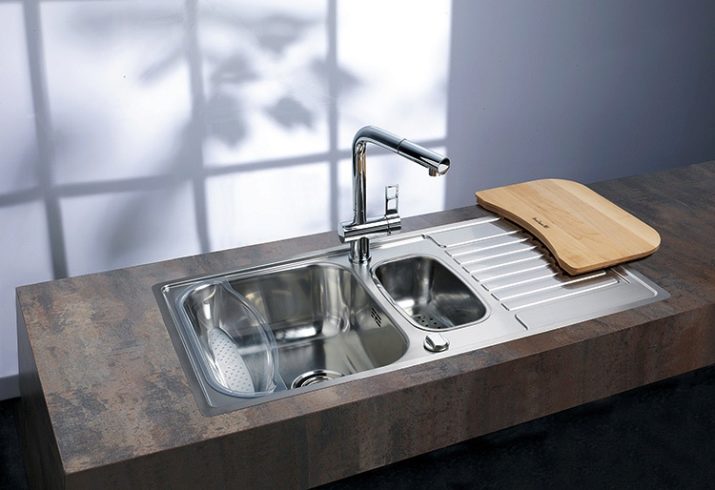
- Franke. This is a company from Germany with a wealth of experience in the manufacture of kitchen sinks. Her first products were stainless steel sinks. One of the features of the product is an unthinkable list of possibilities, which can sometimes change the consumer's imagination about comfort and simplicity. The appearance of the sinks is another reason for the pride of the company.
Products are available with various types of sanding - from matt to glossy surfaces.
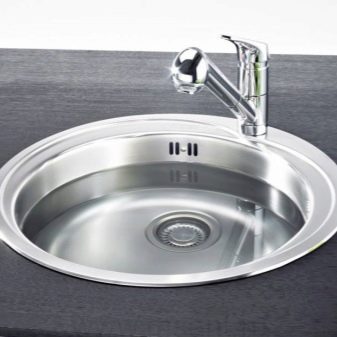
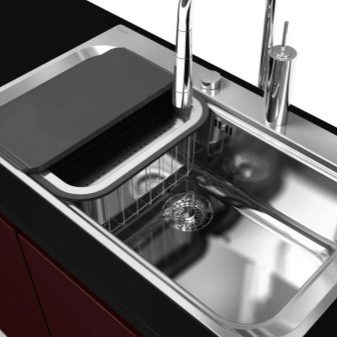
- Blanco... Products from this company from Germany are synonymous with quality. Other manufacturers of kitchen sinks can only envy this choice of stainless steel products, as well as the established reputation of the brand over 90 years of activity.
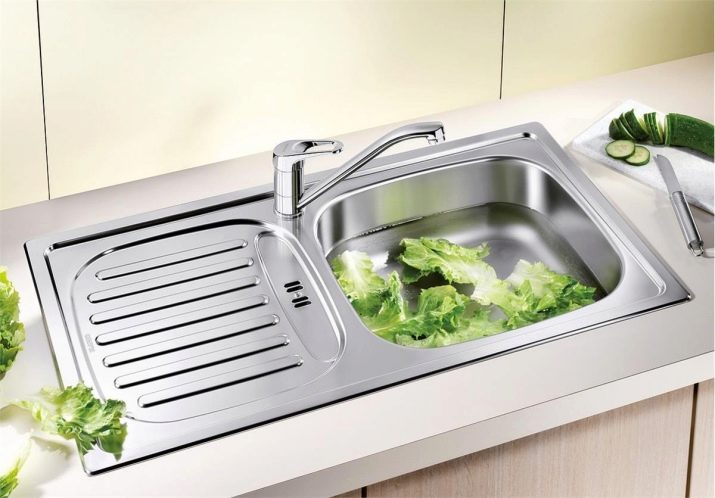
How to choose?
When choosing a stainless steel sink for the kitchen, the following subtleties must be taken into account:
- steel grade - it is advisable to use a brand with an index of 304; a brand with an index of 204 is cheaper, but also less durable and of high quality;
- metal thickness - the thicker the iron, the stronger the sink, today sinks with wall thickness on a scale of 0.4 to 1.2 millimeters are offered; the smaller this value, the less the shell will serve, and the more rumble it will produce, but an increase in the thickness of the metal will inevitably lead to an increase in the price of the product;
- auxiliary coating - some manufacturers apply a soundproof and moisture-proof coating, which increases the cost but increases the degree of convenience;
- dimensions - the dimensions of the inset sink must correspond to the mounting dimensions of the bedside table;
- manufacturer's warranty - many people often forget about this important point;
- and, of course, the hostess should directly choose a sink for the stainless steel kitchen - who, if not her, according to statistics, will need to use it for almost a third of the time while at home.
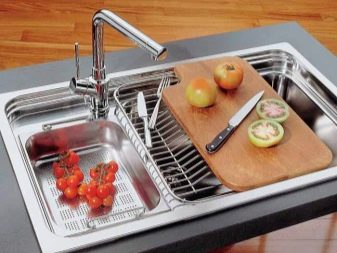
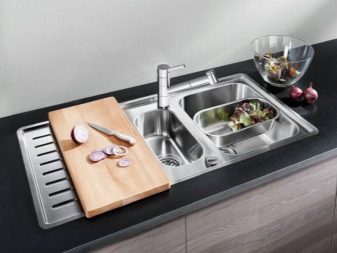
How to care?
The basic rule is, of course, constant grooming. If it is accidental, it will be much more difficult to restore the original gloss of the sink, if not impossible. To do this, after any use of the sink, wash it with warm water, remove fragments of food from the drain grid and wipe it dry. Such procedures will make it possible to prevent the occurrence of drips on the sink drain and on its walls.
The smallest once a week, wash the sink with a sponge using detergentsspecially designed for the care of non-corrosive steel products. These are usually liquids and gels. Following this, the sink must be lubricated with some edible oils, they excellently protect the steel.
The use of powders containing abrasives is undesirable, as they leave scratches and the surface gradually fades. If for some reason the sink is decently dirty, fill it with water for several hours and add vinegar. After which it should be treated with a detergent. Next, wipe it dry and cover with oil.
If the water from the water supply system has many inclusions of iron and limestone, which are the source of the appearance of sediment, it is necessary to install special filtering devices in the water supply network.
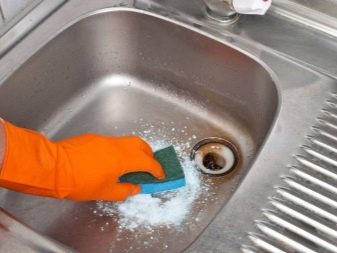
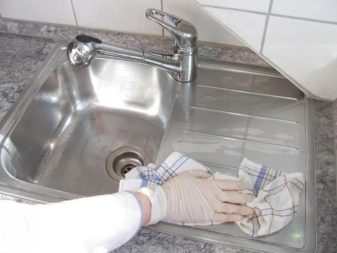
In addition, do not neglect the following recommendations described in the instructions for use of non-corrosive sinks:
- the sink should not be allowed to come into contact with any rusted objects, as this will provoke the appearance of rust stains;
- it is impossible to use sharp things, sandpaper and abrasives for cleaning, as well as active bleaching agents (acids, whiteness, alkalis, etc.);
- the sink should be used exactly as intended; it should not be turned into a chemical laboratory or the site of a craftsman's workshop.
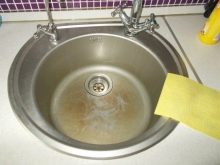
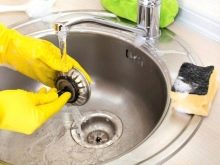
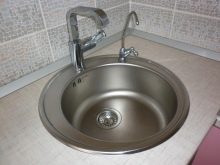
For information on how to choose a steel kitchen sink, see the next video.








